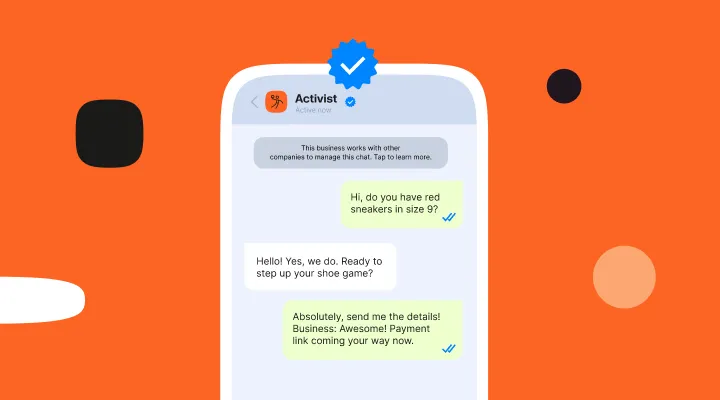What is an in-app notification?
In-app notifications are messages inside your mobile app or web application while using them.
They offer a unique opportunity for businesses to reach users directly, enhance the in-app experience, and drive specific actions without disrupting their broader device usage.
They can:
- Give you updates: New features, changes to the app, or essential account information.
- Guide you: Help you learn how to use the app better or highlight features you might have missed.
- Offer something special: Tell you about promotions, discounts, or rewards.
- Ask for your feedback: Sometimes, they’ll have short surveys or ask for your opinion.

Why are in-app notifications important?
When used thoughtfully, in-app notifications foster a robust and continuous connection between an app and its users. This ultimately boosts retention and drives desired actions.
Enhanced user experience (UX)
Guidance: In-app notifications guide users through new features and complex processes or offer hints when they seem stuck.
Contextual help: They assist immediately, addressing questions or problems as they arise within the app.

Increased engagement
Reminders: In-apps can nudge users to complete abandoned tasks, like finishing a profile or trying out a feature they have yet to explore.
Personalized interaction: Targeted notifications based on user behavior make the app feel more responsive and tailored to individual needs.
Boosting conversions
Targeted promotions: Delivering offers, upgrade prompts, or limited-time sales directly within the app when a user is engaged enhances their chance of action.
Streamlined processes: In-app notifications gently guide users through essential steps in the sales funnel, increasing their willingness to convert.

Gathering user feedback
Surveys: Collecting feedback through tools like surveys or quick reactions inside the app captures the natural and contextualized user sentiment.
Pinpointing improvements: The data gained from in-app feedback lets product teams know exactly where to focus their development efforts to create a better app experience.

What are in-app notification types?
To craft the most effective in-app messaging strategy, we must dissect the different types of in-app notifications:
Modals: These full-screen overlays are attention-grabbing and ideally reserved for critical updates, time-sensitive announcements, or crucial steps in the onboarding process. Their advantage lies in their commanding presence, but exercise caution, as overuse can negatively impact user experience.
Tooltips: Consider tooltips the whisper of in-app communication. Compact and often attached to specific UI elements, these bite-sized notifications offer contextual guidance without significantly interrupting user flow. They are the hidden gems of feature introductions and in-the-moment assistance.
Slideouts: Emerging gracefully from the edges of the screen, slideouts are a middle ground between subtle suggestions and attention-demanding modals. They’re a convenient way to showcase additional information, options, or promotions without being too invasive.
Banners/Toasts: Appearing as transient messages typically along the top or bottom of the screen, banners and toasts act as brief status updates. These excel at announcing background task completion, download progress, or minor success confirmations. Their strength lies in brevity and a non-invasive design.
What are in-app notifications use cases?
In-app notifications can be used across various touchpoints in the user journey to achieve strategic goals:
Onboarding: Guide new users through app functionalities and key actions.
The proper welcome: Personalized greetings and engaging walkthroughs set the tone for new users. In-app notifications can break down the onboarding process into manageable steps, reducing friction and encouraging continuous exploration.
Highlight new features or improvements: Tell users about game-changing updates or hidden value with well-timed in-app notifications. Highlight benefits, include visuals, and provide concise tutorials to maximize adoption and spark excitement.

Deliver special offers & promotions: Target the right users at the right time with incentives such as coupons, loyalty rewards, or upgrade discounts presented directly within the app. Personalization ensures these offers resonate, enhancing user satisfaction and potential upsells.

Account maintenance & security: Stay one step ahead by using in-app notifications to prompt password updates, address pending actions, or communicate timely security reminders. Such interventions demonstrate a proactive approach, strengthening user trust.
Just-in-time help: Make in-app support a seamless experience. Use tooltips or contextual guidance to provide hints and explanations when users encounter friction within a task or feature. This on-demand help can turn user confusion into positive reinforcement.
Five examples of in-app notifications
These real-world examples demonstrate how popular apps strategically employ in-app notifications:
Slack: New feature discovery becomes easy thanks to clear tooltips that explain fresh additions and contextual updates within the Slack workspace.
Dropbox: File uploads, shared links, and account changes are signaled with unobtrusive banners, allowing users to track progress within the app.
Duolingo: The language learning app leverages playful models to celebrate milestones and streak accomplishments, boosting user motivation and solidifying app loyalty.
Asana: Slideouts tactfully reveal task summaries, comments, or related options alongside the primary work view, allowing users to dive deeper without ultimately shifting their focus.
Grammarly: When reviewing your writing, Grammarly inserts discreet tooltips next to suggested edits, explaining the reasoning behind those suggestions for an educational touch.
In-app message best practices
Transforming the potential of in-app notifications into real results demands a thoughtful approach. These best practices ensure your messages bolster user experience rather than hinder it:
Personalize to resonate: Data is your secret weapon. Segment your audience based on user behavior, history, or app preferences to tailor uniquely relevant notifications. A generic blast lacks impact compared to a message addressing a specific user need.
Timing is everything: Consider the user’s journey. Are they mid-task? New to the app? Deliver your message at the moment of highest potential impact, and use intelligent triggers to avoid untimely disruptions.
Visuals can do the talking: Icons, graphics, or subtle animations enhance your message while adhering to your app’s design language. Visual elements capture attention and can quickly convey additional information.
Prioritize: In-app notifications are powerful, but too much of a good thing becomes annoying fast. Be selective with your messages, focusing on what delivers the most value to the user. Allow adequate frequency control or let users adjust notification settings.
In-app notifications vs. push notifications
It’s crucial to distinguish in-app notifications from push notifications as they have distinct advantages and use cases depending on your goals. Let’s compare:
| Feature | In-app notification | Push notification |
|---|---|---|
| Delivery | Appears inside the active app. | Arrives outside the app, on the device’s lock screen or notification center. |
| Audience | Engaged users currently in the app. | Can reach users even when the app is not running, broader audience potential. |
| Purpose | Provides timely guidance, enhances in-app experience, drives feature discovery, promotes in-app actions. | Primarily designed to re-engage inactive users, deliver time-sensitive alerts, and drive users back into the app. |
| Control | May be designed to require dismissal for critical information. | Users typically have complete control over disabling push notifications or customizing their settings. |
FAQs
Related content

How network API capabilities strengthen security
Telecom is becoming smarter, and network APIs are leading the way. Discover how these tools are transforming telecom security, enabling real-time verification, fraud prevention, and smarter services.

WhatsApp newsletter guide [Create & send WhatsApp newsletter]
A WhatsApp newsletter allows businesses to share updates, promotions, and important information directly within a familiar chat environment.

WhatsApp Business numbers & virtual numbers guide (2025)
Learn how to get, verify, and manage your WhatsApp Business number using the WhatsApp Business App or Platform. Explore types of numbers, setup steps, best practices, troubleshooting, and how Infobip helps scale your messaging.







